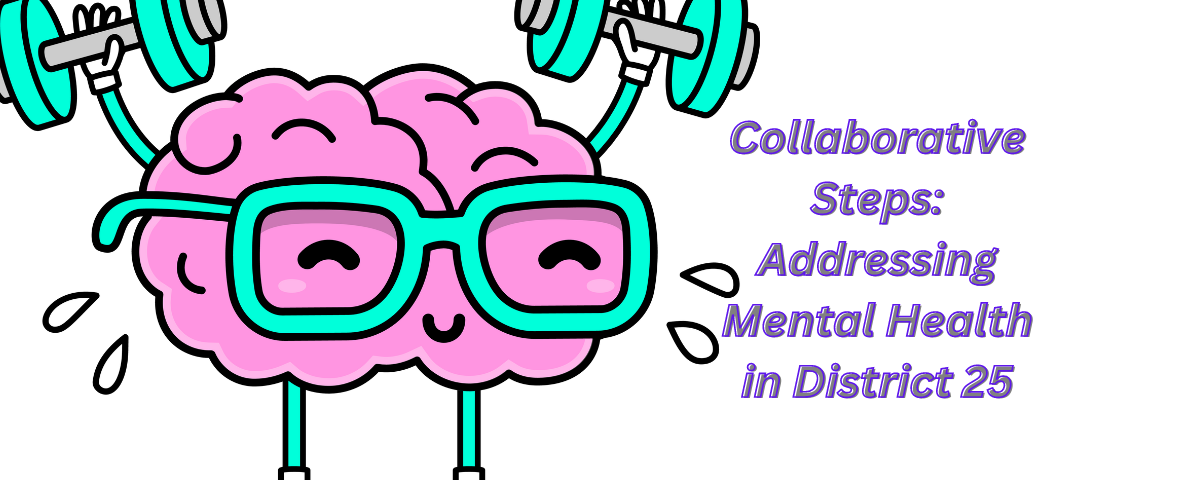
District 25’s Path to Progress: Investing in Roads and Bridges
February 13, 2024
Infrastructure Investment: Retired Colonel Vince Crabb Runs for Congressional District 25 in Texas
February 20, 2024FAQs
Collaborative Steps: Addressing Mental Health in District 25
A. How can individuals contribute to mental health initiatives in District 25?
Individuals can contribute by staying informed, participating in community programs, and fostering open conversations about mental health.
B. Are there specific resources available for families dealing with mental health challenges?
Yes, counties and respective cities in District 25 provide resources such as support groups, counseling services, and educational programs tailored to families dealing with mental health challenges.
C. How can workplaces promote a stigma-free environment for mental health discussions?
Workplaces can promote a stigma-free environment by implementing mental health policies, providing training, and encouraging open communication among employees.
D. What role do schools play in addressing mental health, and how can parents get involved?
Schools play a crucial role by integrating mental health into the curriculum and providing support services. Parents can get involved by participating in school initiatives, attending workshops, and fostering mental health discussions at home.
E. Where can individuals seek help if they are personally struggling with mental health issues?
Individuals can seek help from local mental health hotlines, community organizations, or licensed mental health professionals. It’s important to reach out and ask for support when needed.
Collaborative Steps: Addressing Mental Health in District 25
In the bustling and diverse community of District 25, the discourse around mental health is gaining prominence. The recognition of mental health challenges as a shared responsibility is fostering collaborative efforts to create a supportive and resilient community. This blog post delves into the collaborative steps taken in District 25 to address mental health issues comprehensively.
I. Introduction
A. Brief Overview of Mental Health in District 25
District 25, like many rural and urban areas, faces a myriad of mental health challenges affecting individuals of all ages. From stress-related issues to more severe conditions, the impact on both individuals and the community as a whole cannot be underestimated.
B. Importance of Collaboration in Addressing Mental Health
Addressing mental health issues requires a united front. Collaborative efforts involving government bodies, community organizations, and educational institutions are essential to create a holistic approach to mental well-being.

II. Understanding Mental Health Issues
A. Prevalent Mental Health Challenges
Before addressing mental health issues, it’s crucial to understand the prevalent challenges in District 25. Common issues include anxiety, depression, and the stigma attached to seeking help.
B. Impact on Individuals and Communities
The ripple effect of mental health challenges extends beyond individuals, affecting families, workplaces, and the overall community. Recognizing this impact is the first step toward a collective solution.
C. The Need for a Comprehensive Approach
A comprehensive approach involves not only treating existing mental health issues but also preventing new cases through education, awareness, and creating a supportive environment.
III. Collaborative Initiatives in District 25
A. Governmental Programs
Governmental programs play a pivotal role in providing essential resources and support. Initiatives focused on mental health awareness campaigns, accessible healthcare, and community outreach are making strides in District 25.
B. Community Organizations and Support
Community organizations act as pillars of support, offering counseling services, support groups, and safe spaces for open discussions. Their grassroots approach connects with individuals on a personal level.
C. Involvement of Educational Institutions
Schools and colleges actively participate in mental health initiatives. Integrating mental health education into the curriculum, training teachers, and fostering a safe learning environment contribute to a healthier future generation.
IV. Breaking the Stigma
A. Public Awareness Campaigns
Public awareness campaigns highlight the importance of mental well-being, encouraging open conversations and reducing judgment.
B. Importance of Open Conversations
Open conversations create a culture where individuals feel comfortable discussing their mental health. Encouraging dialogue in homes, schools, and workplaces normalizes seeking help when needed.
C. Celebrating Success Stories
Sharing success stories of individuals overcoming mental health challenges provides hope and inspiration. Celebrating resilience fosters a sense of community and support.
V. Building Support Networks
A. Establishing Helplines and Resources
Providing easily accessible helplines and resources ensures that individuals in need can reach out for support. These networks act as lifelines during critical moments.
B. Encouraging Peer Support
Peer support is a powerful tool in the fight against mental health challenges. Encouraging individuals to lean on their peers for understanding and empathy creates a robust support system.
C. Involving Families in the Process
Recognizing the role of families in an individual’s mental well-being, initiatives involve families in the support process. Educating families on mental health and providing resources strengthens the overall support network.
VI. Mental Health Education in Schools
A. Integrating Mental Health into the Curriculum
Education is a key element in combating stigma. Integrating mental health into the school curriculum ensures that young minds are equipped with the knowledge and empathy needed to address mental health challenges.
B. Training Teachers and Staff
Ensuring that educators are trained to recognize signs of mental health issues allows for early intervention. This training also fosters a supportive environment where students feel understood and cared for.
C. Fostering a Safe Learning Environment
Creating a safe learning environment is crucial for the mental well-being of students. Schools are focusing on reducing stressors, providing mental health resources, and promoting open communication.
VII. Workplace Mental Health Programs
A. Employer Responsibility
Workplaces play a significant role in employee well-being. Employers are recognizing their responsibility to create environments that prioritize mental health, including flexible work schedules and mental health days.
B. Employee Well-being Initiatives
Employee well-being initiatives, such as wellness programs and mental health workshops, are becoming common in workplaces. These initiatives aim to reduce workplace stress and promote a healthier work-life balance.
C. Encouraging Work-Life Balance
Recognizing the importance of work-life balance contributes to better mental health. Encouraging employees to take breaks, use vacation time, and prioritize self-care fosters a positive work environment.
VIII. Technology and Mental Health
A. Utilizing Apps and Online Resources
Technology plays a crucial role in mental health initiatives. Apps and online resources provide accessible tools for managing stress, tracking moods, and connecting with mental health professionals.
B. Telehealth Services
Telehealth services have become integral in providing mental health support, especially in times of restricted physical access. Virtual therapy sessions and online support groups offer flexibility and convenience.
C. The Role of Social Media in Mental Health
Social media, when used responsibly, can be a powerful platform for mental health advocacy. Communities on social media provide a sense of belonging and support, breaking the isolation often associated with mental health challenges.
Insurance Benefits and Job – search Activities: Debunking Myths
IX. Addressing Specific Demographics
A. Tailored Programs for Different Age Groups
Recognizing that different age groups have unique mental health needs, tailored programs address the specific challenges faced by children, adolescents, adults, and seniors.
B. Cultural Sensitivity in Mental Health Initiatives
Cultural sensitivity ensures that mental health initiatives respect diverse backgrounds and beliefs. Customizing programs to reflect the cultural context of District 25 increases their effectiveness.
C. Gender-Specific Approaches
Acknowledging gender-specific mental health challenges allows for targeted support. Initiatives cater to the unique needs and experiences of both men and women.

X. Measuring the Impact
A. Metrics for Success
Measuring the success of mental health initiatives requires clear metrics. Tracking the number of individuals reached, reduction in stigma, and increased help-seeking behavior are essential indicators.
B. Continuous Improvement Strategies
Adapting and improving mental health initiatives based on feedback and evolving needs is crucial. Continuous improvement ensures that programs remain effective and relevant.
C. Learning from Challenges
Challenges are inevitable, but learning from them is essential. Identifying and addressing challenges strengthens the overall approach to mental health in District 25.
XI. Collaborative Success Stories
A. Showcasing Positive Outcomes
Highlighting success stories of individuals, families, and communities overcoming mental health challenges inspires others. These stories serve as beacons of hope and motivation.
B. Encouraging Replication in Other Districts
The lessons learned from collaborative efforts in District 25 can serve as a blueprint for other districts facing similar challenges. Sharing experiences and strategies encourages widespread adoption.
C. Celebrating Achievements
Celebrating achievements, both big and small, is crucial for maintaining momentum. Recognizing the collective efforts of the community boosts morale and encourages sustained commitment.
XII. Future Directions
A. Evolving Mental Health Landscape
The mental health landscape is dynamic, requiring ongoing adaptation. Staying abreast of new research, technologies, and societal changes ensures that initiatives remain effective.
B. Adapting to New Challenges
New challenges will inevitably arise, and flexibility in approach is essential. Collaborative efforts must be agile in addressing emerging issues and adjusting strategies accordingly.
C. The Role of Technology in Future Initiatives
As technology evolves, its role in mental health initiatives will expand. Embracing innovative technologies ensures that mental health support remains accessible and relevant.
XIII. Conclusion
A. Recap of Collaborative Steps
In conclusion, the collaborative steps listed in this post present a comprehensive and forward-thinking approach to mental health. By addressing challenges head-on, breaking stigma, and fostering support networks, the community is creating a healthier, more resilient environment.
B. Encouraging Ongoing Efforts
The journey towards mental well-being is ongoing. Encouraging individuals, organizations, and institutions to maintain their commitment ensures a sustained positive impact.
C. A Unified Approach for a Healthier District 25
The collaborative efforts underscore the power of a unified approach to mental health. By working together, District 25 can shape a future where mental well-being is prioritized, and individuals thrive.

